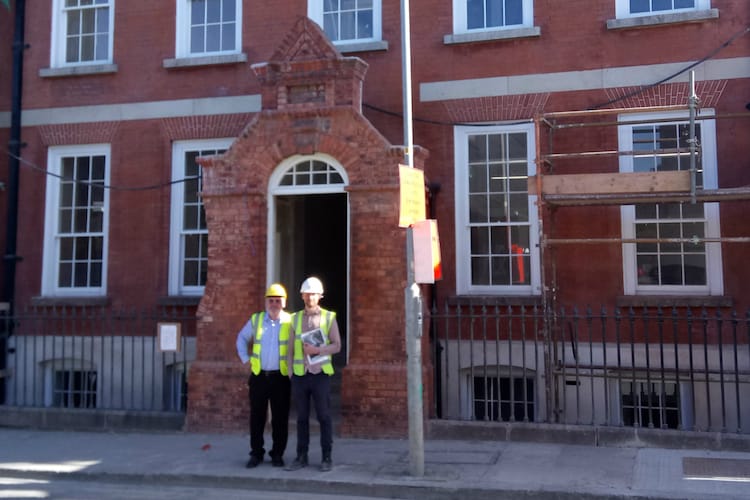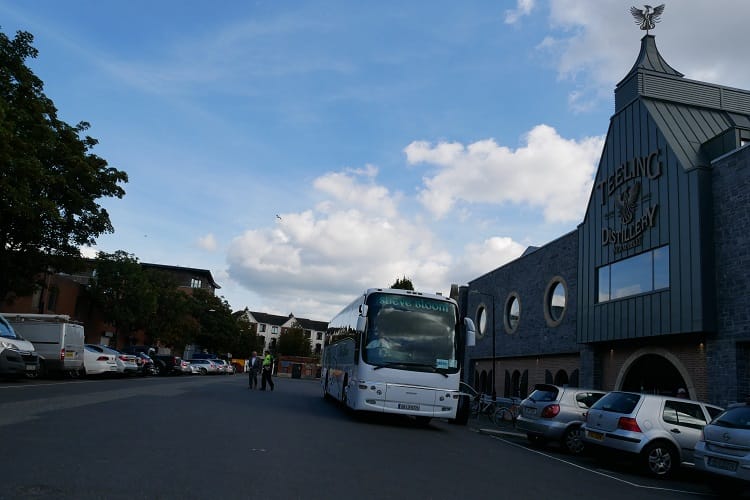What’s the best way to tell area residents about plans for a new asylum shelter nearby?
The government should tell communities directly about plans for new asylum shelters, some activists and politicians say.
While there are concerns about how a planned redevelopment of Newmarket Square will affect local businesses, the developers behind the project say it will be good for everybody.

If the planned redevelopment of Newmarket Square goes ahead, it will mean more, not less market space, says Martin Creedon.
The Newmarket Partnership, headed up by Martin Creedon and Robin Simpson, has submitted plans for the transformation of the square that include the addition of a hotel, a micro-brewery, offices, apartments, a pub and a café, and plenty of additional market space, Creedon says.
These plans propose demolishing the buildings that currently host the Dublin Food Co-op and the Green Door Market, and replacing them with new buildings of between two and six storeys. Separate plans propose also demolishing other buildings across the square.
“The common misconception is that the market is going to be gone,” says Matthew Creedon. But “nothing could be further from the truth”, he says.
At the Creedon Group offices on in Newmarket Square on Monday, Martin Creedon and Matthew Creedon, directors of the Creedon Group, sit around a large board table. Plans for the transformation of Newmarket Square are displayed on a large raised screen in the corner.
The Dublin Food Co-op and the Green Door Market combined have about 17,000 square feet of market space. Creedon says the amount of market space at the square would actually increase to 26,000 square feet after the re-development.
But Dublin City Council planners disagree, according to planning documents. By their count, after the redevelopment would be 2,852 square feet of market space at Newmarket Square.
What accounts for this large difference? Creedon is including the area of the purpose-built outdoor market that the council has proposed for the main square, and a what planners call a “courtyard”, which is proposed for a spot behind the buildings currently standing on the north side of the square.
He’s also counting all the retail space inside the buildings on the square as market space. Much of that space will be rotated between different businesses on different days, he says.
Some have voiced concerns about the future of the independent businesses that currently operate in Newmarket Square, including the Dublin Food Co-op, Dublin Flea Market, and Green Door Market.
“There’s an awful lot of uncertainty,” Aisling Rogerson, one of the founders of Dublin Flea Market, said in July. “We haven’t been reassured by anyone, neither Dublin City Council nor any of the developers, whether we’ll still be allowed to trade in Newmarket.”
Matthew Creedon says critics of the redevelopment must not have reviewed the plans.
While the offices, the hotel, and apartments will make up the majority of the new development, the markets are a very important element of it too, he says. “That is the spirit of the area. It’s Newmarket,” he says, “We have zero intention of getting rid of that.”
Those who want to run outdoor stalls can negotiate directly with Dublin City Council, which has draft plans for a purpose-built, outdoor market at the site, he says. “That would be an issue between them and DCC. DCC will be issuing the licences,” says Martin Creedon.
The price of each retail/market space indoors, in the buildings that will replace those that now house the Co-op and the Green Door Market, will go up with the redevelopment, Martin Creedon says, but it will be affordable to all types retailers if they are willing to collaborate with each other and share space.

Martin and Matthew Creedon say they developed the plans for Newmarket after visiting markets in Ireland and abroad. “We have been to markets in New York, France, Italy, Spain, and Limerick,” says Martin Creedon.
He hopes Newmarket will operate seven days a week, but most stall holders won’t use the space seven days a week, he says.
So, in his vision one section of the indoor market/retail space could be a fish market on Friday, a vintage clothes market on Saturday and a jewellery market on Sunday.
“Concertina” style doors, that is doors that slide back and fold up, will divide the indoor space, allowing versatility so that different retailers can make use of space in different ways. The indoor market will open out onto the outdoor market in the square, he says.
The plans include adding another outdoor market square too, he says. “We are not getting rid of the market, we are adding a new square and it’s the same size as Newmarket,” he says, referring to the square or “courtyard” proposed for the site to the north of the main square.
The plans have come in for criticism from some residents, who have filed objections arguing that they do not include enough housing. There are 94 apartments planned, 10 percent of which would be social housing, in line with legal requirements.
Dublin Food Co-op have been based in Newmarket since 2007, and are tenants of the Creedon Group.
Sam Toland of the Dublin Food Co-op says they hope to continue to serve the vibrant community they have helped to build, into the future.
“During our discussions with both Dublin City Council and the Newmarket Partnership, they have expressed a clear understanding of the unique contribution that Dublin Food Co-op makes to the social and economic life of Newmarket,” he said.
Martin Creedon says he hopes the Co-op will continue to rent from him and benefit from the increased footfall in the area. “They are part of the Newmarket story,” says Matthew Creedon.
But their rent will be going up. “It has to be economic, but no one knows yet what price it will be,” says Martin Creedon. “It will be more expensive than it currently is.”
Discussions with the stakeholders are ongoing, and if planning permission is approved, they’ll be in a better position to hammer out deals, he says.
The re-development project is in collaboration with Dublin City Council, and delivers on what was envisaged in the Local Area Plan, says Martin Creedon. “That is what … was voted in by the councillors and what we are producing is what they wanted,” he says.

Dublin City Council’s local area plan envisages the future of the square as being “reborn as a new city destination accommodating markets, events, performances and outdoor seating for its many cafés and restaurants”.
“The organic food market occupies new premises facing the square, along with shops, artisans’ workshops, galleries, a bar and micro-brewery, it also has community, arts and leisure facilities,” the plan says.
Martin Creedon takes out a large folder from a shelf and places it on the table, and starts to read from the area plan. “We have been working with DCC on these plans for maybe five years,” he says.
The Local Area Plan (LAP) calls for improved permeability, enhancing the public realm and market square, encouraging daytime and night-time activities, and “a high quality, multi-functional market square”.
Says Martin Creedon: “Now, I would suggest that the [Toyota] HiAce van, the farmer’s-market-type that calls up on a Saturday and sells their wares, is not what the LAP is looking for.”
So what is the future for farmer’s marketeers in the new New Market Square? “Our vision for it is the enhancement of the type of market that is there and a lot of the people that are involved at the moment can be involved,” he says.
Creedon says he believes that local residents will support the plans once they understand that the market is being retained, he says.
“We have been chatting to local Liberties craft-beer people, and we are thinking the brewery could be a collaboration between six or seven local beers and celebrating the Liberties,” says Martin Creedon.
“This will not be Guinness craft beer,” says Martin Creedon.
It will be “small-scale, artisan beer”, says Matthew Creedon.
Their plans also call for a restaurant and café attached to the micro-brewery, and that would be located where the Dublin Food Co-op and Creedon Group offices currently stand, he says.
They hope that some of those who visit the area for one reason will then be attracted to the others, including to the markets. They also say their plans will boost employment in the area from what they estimate at about 100 now to 2,000 after the redevelopment.
Get our latest headlines in one of them, and recommendations for things to do in Dublin in the other.